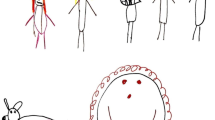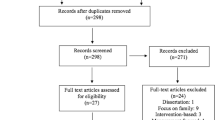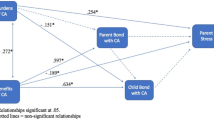Abstract
While the importance of secure relationships between children and caregivers has been well established in the literature as an essential feature of healthy child development, the influence of animal-human relationships on healthy development and attachment is also beginning to gain attention. A burgeoning literature supports the developmental and sustainability benefits of such relationships to children. One hundred seventeen directors of childcare centres in Manitoba, Canada (16.5%) caring for 24% of children in licensed care responded to a survey about animals in childcare facilities. Findings showed that only 51% of facilities currently had animals, with fish and caged rodents being the most common. Although centre directors agreed that the benefits of centre-based animals included children learning responsibility as well as increased calmness and happiness in children, the drawbacks in terms of children’s allergies, the costs, and the inconvenience outweighed these benefits in almost half the centres. Given the benefits of animals in young children’s lives, a list of variables for consideration is provided to aid directors in decision-making about animals in childcare centres.


Similar content being viewed by others
References
Allen, K. M., Blascovich, J., & Mendes, W. B. (2002). Cardiovascular reactivity in the presence of pets, friends, and spouses: The truth about cats and dogs. Psychsomatic Medicine,64(5), 727–739.
Barker, S., Best, A., Fredrickson, M., & Hunter, G. (2000). Constraints in assessing the impact of animals in education. Anthrozoos,13(2), 74–79. https://doi.org/10.2752/089279300786999905.
Baruch, Y. (1999). Response rate in academic studies a comparative analysis. Human Relations - New York,52(4), 421–438.
Born, P. (2018). Regarding animals: A perspective on the importance of animals in environmental early childhood education. International Journal of Environmental Early Childhood Education,5(2), 46–57.
Bowlby, J. (1969). Attachment. New York: Basic Books.
Bowlby, J. (1973). Attachment and loss, Vol. 1. Attachment. New York: Basic Books.
Brelsford, V., Meints, K., Gee, N., & Pfeffer, K. (2017). Animal-assisted interventions in the classroom: A systemic review. International Journal of Environmental Research and Public Health,14, 669–702.
Bronfenbrenner, U. (1979). The ecology of human development. Cambridge, MA: Harvard University Press.
Carr, S., & Rockett, B. (2017). Fostering secure attachment: experiences of animal companions in the foster home. Attachment & Human Development,19(3), 259–277. https://doi.org/10.1080/14616734.2017.1280517.
Charnetsky, C. J., Riggers, S., & Brennan, F. (2004). Effect of petting a dog on immune system functioning. Psychological Reports,3(2), 1087–1091.
Creswell, J., & Cresswell, D. (2018). Research design: Qualitative, quantitative, and mixed methods approaches. Thousand Oaks, CA: Sage.
Fan, W., & Yan, Z. (2010). Factors affecting response rates of the web survey: A systematic review. Computers in Human Behavior,26(2), 132–139.
Friedmann, E., & Thomas, S. (1995). Pet ownership, social support, and one-year survival acute myocardial infarction in the cardiac arrhythmia trial suppression trial. American Journal of Cardiology,76, 1213–1217.
Friedmann, E., & Tsai, C.-C. (2006). The animal-human bond: Health and wellness. In A. Fine (Ed.), Animal-assisted therapy: Theoretical foundations and practice guidelines (2nd ed., pp. 95–117). San Diego: Academic Press.
Friesen, L. (2010). Exploring animal-assisted programs with children in school and therapeutic contexts. Early Childhood Education Journal,37, 261–267. https://doi.org/10.1007/s10643-009-0349-5.
Handlin, L., Nilsson, A., Ejdeback, M., Hydbring-Sandberg, E., & Uvnas-Moberg, K. (2012). Associations between the psychological characteristics of the human-dog relationship and oxytocin and cortisol levels. Anthrozoos,25(2), 215–228. https://doi.org/10.2752/175303712x13316289505468.
Hawkins, R., & Williams, J. (2017). Childhood attachment to pets: Associations between pet attachments, attituded towards animals, compassion, and humane behavior. International Journal of Environmental Research and Public Health,14, 490–505.
Hergovich, A., Monshi, B., Semmler, G., & Zieglmayer, V. (2002). The effects of the presence of a dog in the classroom. Anthrozoos,15, 37–50.
Jalongo, M. (2008). Beyond a pets theme: Teaching young children to interact safely with dogs. Early Childhood Education Journal,36(1), 36–45.
Jalongo, M. (2015). An attachment perspective on the dog-child bond: Interdisciplinary and international research findings. Early Childhood Education Journal,43, 395–405. https://doi.org/10.1007/s10643-015-0687-4.
Kotrschal, K., & Ortbauer, B. (2003). Behavioural effects of the presence of a dog in a classroom. Anthrozoos,16, 147–159. https://doi.org/10.2752/089279303786992170.
Levinson, B., & Mallon, G. (1997). Pet-oriented child psychotherapy. Springfield, Illinois: Charles C. Thomas Publishers.
Maruyama, M. (2010). The effects of animals on children’s perspective-taking abilities. Doctoral dissertation. Portland State University.
McRobbie, (2017, Aug 1). Should we stop keeping animals as pets? Why more and more ethicists say yes. The Guardian. Retrieved July, 2016 from https://www.theguardian.com/lifeandstyle/2017/aug/01/should-we-stop-keeping-pets-why-more-and-more-ethicists-say-yes
Melson, G. F. (2003). Child development and the human-companion animal bond. Animal Behavioral Scientist,47(1), 31–39.
Melson, G., & Fine, A. (2010). Animals in the lives of children. In A. Fine (Ed.), Handbook on animal-assisted therapy: Theoretical foundations and guidelines for practice (pp. 481–505). Amsterdam: Elsevier.
Meyers, O., Saunders, K., & Garrett, E. (2004). What do children think animals need? Developmental trends. Environmental Education Research,10(4), 545–562. https://doi.org/10.1080/1350462042000291056.
Passantino, A. (2008). Companion animals: An examination of their legal classification in Italy and the impact on their welfare. Journal of Animal Law,4, 59–91.
Province of Alberta. (2014). Consumer corner: Canadian pet market outlook 2014. Retrieved Jan 30, 2016 from http://www1.agric.gov.ab.ca/$department/deptdocs.nsf/all/sis14914
Schofield, G., & Beek, M. (2005). Providing a secure base: Parenting children in long-term foster family care. Attachment & Human Development,7, 3–26. https://doi.org/10.1080/14616730500049019.
Serpell, J., Coppinger, R., Fine, A., & Paralta, J. (2010). Welfare consideration in therapy and assistance animals. In A. Fine (Ed.), Handbook on animal-assisted therapy: Theoretical foundations and guidelines for practice (pp. 481–505). Amsterdam: Elsevier.
Sokal, L., & Kahl, A. (in press). The effects of animal-assisted activities (AAA) on minority students at a boarding school in Germany. The McGill Journal of Education.
Steffen, W., Crutzen, P., & McNeill, J. R. (2007). The anthropocene: Are humans now overwhelming the great forces of nature?”. AMBIO: A Journal of the Human Environment36, 614–621. https://doi.org/10.1579/0044-7447.
Taylor, A., & Pacini-Ketchabaw, V. (2018). The common worlds of children and animals: Relational ethics for entangled lives. London and New York: Routledge.
Tipper, B. (2011). ‘A dog who I know quite well’: Everyday relationships between children and animals. Children’s Geographies,9(2), 145–165. https://doi.org/10.1080/14733285.2011.562378.
Virues-Ortega, J., & Buela-Casals, G. (2006). Psychophysiological effects of human-animal interaction: Theoretical issues and long-term interaction effects. Journal of Nervous and Mental Disease,194(1), 52–57.
Walsh, F. (2009). Human-animal bonds 1: The relational significance of companion animals. Family Process,48(4), 462–480. https://doi.org/10.1111/j.1545-5300.2009.01296.x.
Wedl, M., & Kotrscha, K. (2009). Social and individual components of animal contact in preschool children. Anthrozoos,22(4), 383–396.
Xumalo, F., & Pacini-Ketchabaw, V. (2017). ‘Staying with the trouble’ in child-insect-educator common worlds. Environmental Education Research,23(10), 1414–1426. https://doi.org/10.1080/13504622.2017.1325447.
Zilcha-Mano, S., Mikulincer, M., & Shaver, P. (2011). Pet in the therapy room: The attachment perspective on animal-assisted therapy. Attachment and Human Development,13(6), 541–561.
Acknowledgements
I gratefully acknowledge the assistance and co-operation of Manitoba Early Learning and Childcare, the childcare Directors who participated, Manitoba Health, Seniors, and Active Living, and Elin Ibrahim of Red River College. I appreciate your time and expertise in informing this work and in supporting the quality care and healthy development of Manitoba children.
Author information
Authors and Affiliations
Corresponding author
Additional information
Publisher's Note
Springer Nature remains neutral with regard to jurisdictional claims in published maps and institutional affiliations.
Rights and permissions
About this article
Cite this article
Sokal, L. Balancing Benefits and Risks of Animal-Assisted Activities (AAA) in Child Care Centres. Early Childhood Educ J 48, 273–283 (2020). https://doi.org/10.1007/s10643-019-00982-0
Published:
Issue Date:
DOI: https://doi.org/10.1007/s10643-019-00982-0




